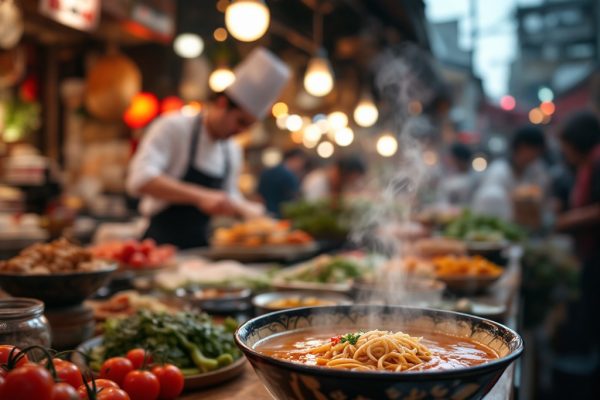How to Order Food in Italian: A Few Simple Phrases to Learn Before Travel
Want to elevate your Italian dining experience? Mastering basic Italian phrases like “Vorrei” (I would like) and “Il conto, per favore” (The bill, please) can transform your trip. This guide unlocks the secrets of the Italian menu, from “Antipasti” to “Dolci,” and provides essential phrases for ordering, expressing preferences, and handling dietary restrictions. Learn how to make reservations, ask for recommendations, and navigate tipping customs. Discover how a little Italian can lead to better service, more authentic interactions, and a truly unforgettable culinary journey. Start learning now and savor the taste of Italy!
Important information
- Use “Vorrei” (I would like) to order food politely.
- Italian menus typically follow a structure: Antipasti (appetizers), Primi (first course), Secondi (main course), Contorni (side dishes), Dolci (desserts), and Bevande (drinks).
- Communicate dietary needs with “Sono allergico/a a…” (I am allergic to…) or “Non posso mangiare…” (I cannot eat…).
- Request the bill with “Il conto, per favore” (The bill, please).
- A service charge is usually included, but a small tip (5-10%) is appreciated for excellent service.
Introduction to Ordering Food in Italian
Ordering food in Italian enhances your dining experience and shows respect for the local culture. Using phrases like “Vorrei” (I would like) or “Avrò” (I’ll have) demonstrates cultural awareness. To inquire about dishes, use “Hai …?” (Do you have …?). Understanding the menu structure also improves your experience.
Typical Italian Menu Structure
- Antipasti: appetizers.
- Primi: first course.
- Secondi: main course.
- Contorni: side dishes.
- Dolci: desserts.
- Bevande: drinks.
Benefits of Learning Italian Phrases for Travelers
Learning some Italian can greatly enhance your travel experience. It helps you communicate with locals, making it easier to navigate and solve problems. Showing this effort also demonstrates respect for Italian culture, which can lead to more meaningful interactions. Even basic phrases can enrich your trip by fostering connections and cultural exchange. Moreover, knowing some Italian boosts your confidence, allowing you to explore independently and feel more comfortable in unfamiliar situations.
Enhancing Your Dining Experience with Italian
Knowing a little Italian can greatly enhance your dining experiences in Italy. Connecting with the staff through their language often leads to improved service and even tastier meals. It also demonstrates your appreciation for their culture. Simple phrases can make a significant impact.
Buongiorno (good morning/day)
Per favore (please)
Grazie (thank you)
Prego (you’re welcome)
Mi scusi (excuse me)
Using these courtesies contributes to a more authentic and satisfying meal and fosters a genuine connection with the local culture.
Basic Italian Phrases for Ordering Food
Start with greetings. Use “Buongiorno” during the day and “Buonasera” in the evening. Always be polite, using “per favore” (please) and “grazie” (thank you) often. To get someone’s attention, say “Scusi” (excuse me).
Ask for the menu. When you’re ready, request “Il menu, per favore.” For adventurous diners, inquire about daily specials with “Quali sono i piatti del giorno?”.
Place your order. Begin with “Vorrei” (I would like), followed by the dish, for example, “Vorrei la pasta carbonara.” Specify cooking preferences such as “ben cotto” (well-cooked) or “al dente. ”
Inform about allergies. It’s crucial to tell the staff about any allergies. Use “Sono allergico/a a…” (I am allergic to…), for instance, “Sono allergico/a ai frutti di mare” (I am allergic to seafood).
Communicate dietary restrictions. Use “Non posso mangiare…” (I cannot eat…) to share any dietary restrictions.
Greetings and Polite Expressions
Italians greet the day with “Buon giorno,” a phrase used from morning until evening. As dusk settles, the greeting shifts to “Buona sera.” Politeness is key in Italian culture. Simple phrases like “per favore” (please) and “grazie” (thank you) are highly valued and significantly improve interactions.
Key Phrases for Navigating Menus
Politely request the menu.
Ask your server for personalized recommendations.
Inquire about daily specials or a fixed-price menu for budget-friendly options.
If a dish sounds interesting, ask for a description.
Vegetarian diners should inquire about plant-based choices.
Common Phrases for Ordering and Preferences
Expressing your preferences in Italian is simple. Use “Preferisco” (I prefer) or “Vorrei piuttosto” (I’d rather have) to indicate your choice,.
For steak lovers, “al sangue” means rare, while “ben cotto” signifies well-cooked. If you prefer something in between, ask for “poco cotto” (slightly cooked).
Ordering is straightforward; begin with “Per me…” (For me…).
Crucially, communicate any allergies clearly with “Sono allergico a…” (I am allergic to…). Similarly, use “Non posso mangiare…” (I cannot eat…) to specify any dietary restrictions. This ensures a pleasant and safe dining experience.
Expressing Dietary Restrictions and Allergies
Communicating your dietary restrictions in Italian restaurants is crucial for a safe and enjoyable dining experience. Clearly express your needs using phrases like “Sono allergico/a a…” (I am allergic to…), “Non posso mangiare…” (I cannot eat…), or “Ho un’intolleranza a…” (I have an intolerance to…). For example, “Sono allergico/a ai crostacei” (I am allergic to shellfish) or “Non posso mangiare glutine” (I cannot eat gluten) are helpful phrases. While language barriers can sometimes occur, using a translation app or carrying a card listing your allergens can help bridge the communication gap and ensure your meal is prepared safely.
Italian Menu Structure and Courses
Start with Antipasti, the enticing appetizers.
Next, savor a Primi course of pasta or risotto.
Follow this with Secondi, the main course featuring meat or fish.
Conclude your meal with Dolci, delightful desserts.
Contorni indicates available side dishes.
Bevande lists the drinks.
To order an appetizer, try a phrase like, “Come antipasto, vorrei…” (As an appetizer, I would like…). While you can certainly order across categories, understanding this traditional structure enhances your appreciation of the Italian dining experience and the thoughtful progression of flavors.
Understanding Menu Vocabulary
Navigating an Italian menu is easy once you understand its structure. It typically follows a set pattern, starting with Antipasti, the appetizers. Next come the Primi, which are usually pasta or risotto dishes. The Secondi follow, featuring main courses such as meat or fish. These main courses are often accompanied by Contorni, the side dishes. Finally, there’s Dolci for dessert, and Bevande for drinks.
Asking About Specials and Recommendations
Craving today’s specials? Just ask, “Quali sono i piatti del giorno?“.
Need a recommendation? Try “Cosa mi consiglia?“.
Making a Reservation and Dining Out
Reserve a table by phone or online. If calling, use the phrase “Vorrei prenotare un tavolo per [number] persone” (I’d like to reserve a table for [number] of people).
For reservations tomorrow evening, add “per domani sera,” or simply say “this evening”. Specify your desired time using “alle [time]” (at [time]).
Once seated, begin your order with “Vorrei ordinare” (I’d like to order). Use “Vorrei” when ordering dishes, for example, “Vorrei la pasta carbonara,” for a polite touch.
Confirm your order by repeating it to the waiter or asking “È corretto?” (Is that correct?).
Reserving a Table: “Vorrei prenotare un tavolo per [number] persone” (I’d like to reserve a table for [number] people).
For Tomorrow Evening: “per domani sera”
Specifying Time: “alle [time]” (at [time])
Starting Your Order: “Vorrei ordinare” (I’d like to order)
Ordering Dishes (Politely): “Vorrei [dish name]” (I’d like the [dish name])
Confirming Your Order: “È corretto?” (Is that correct?)
How to Make a Reservation in Italian
To book a table, use the following phrases:
For a general reservation: “Vorrei fare una prenotazione per [number] persone per [date] alle [time].” For example, a Friday night reservation at 8 PM for two would be, “Vorrei fare una prenotazione per due persone per venerdì alle otto.”
For specific seating: “Vorrei un tavolo vicino alla finestra” (window table) or “Vorrei un tavolo fuori” (outside table).
Initiating Your Order: Using ‘Vorrei’ and Other Phrases
Use “vorrei” (I would like) for polite ordering, for example, “Vorrei una pasta carbonara” (I would like pasta carbonara).
Say “Vorrei ordinare” (I would like to order) when ready.
Remember “per favore” (please) and “grazie” (thank you) to enhance your dining experience.
Clarifying Your Order: Ensuring Satisfaction
If your order is incorrect, politely inform your server. For example, if you receive regular pasta instead of gluten-free, say “Excuse me, I ordered gluten-free pasta”.
Alternatively, “This is not what I ordered” is also effective.
The best way to avoid issues is to confirm your order before it’s sent to the kitchen. Ask your server to repeat your order by saying “Could you repeat the order, please?”.
Closing the Meal in Italian
Requesting your bill in Italy is simple. Just say “Il conto, per favore.” Tipping customs in Italy differ slightly from other countries. While a service charge (servizio) is often included, a small additional tip is appreciated for excellent service. You could round up the bill or leave a few extra euros. If the service was subpar and a service charge is already included, no further tip is necessary.
Requesting the Bill: ‘Il Conto, Per Favore’
Getting the bill in Italy is easy. Simply say, “Il conto, per favore,” meaning “The bill, please”. Alternatively, “Il conto, prego” politely indicates you’re ready to pay. Either phrase works perfectly.
Understanding Tipping Practices in Italy
In Italy, a service charge (*coperto*) is usually included in your bill, covering bread, water, and table setting. This means tipping isn’t required. However, for outstanding service, a small extra tip (*la mancia*) of 5-10% is appreciated. You can leave the tip on the table or give it directly to your server.











